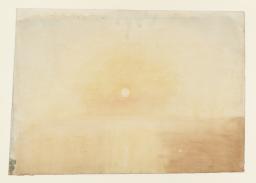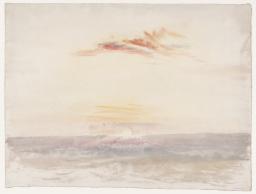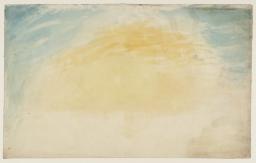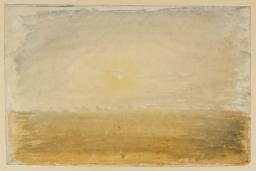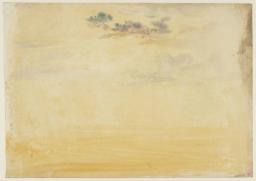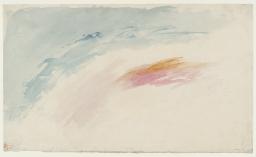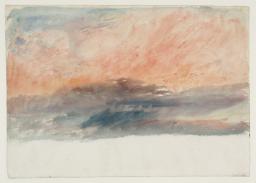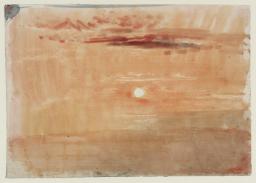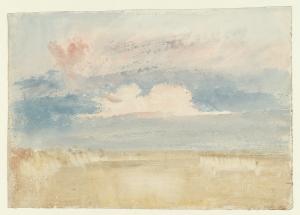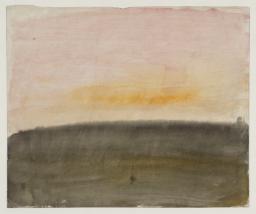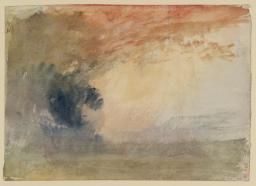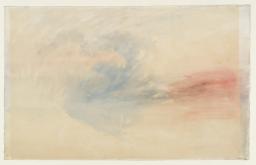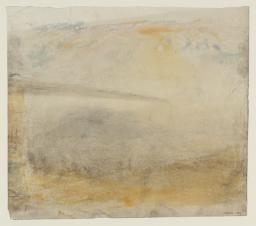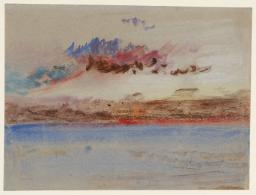Turner Bequest CCLXIII 64, 68, 78, 136, 137, 170, 207, 208, 209, 210, 271, 283, 289, 301, 353, 389, CCXCII 75
This subsection comprises ‘colour beginnings’ predominantly characterised by their focus on the sun itself, or its effects on the sky and clouds at dawn or sunset. Some include a band of nondescript landscape or sea, not developed enough for them to be included in sections elsewhere in the present catalogue such as the present author’s ‘England and Wales Colour Studies c.1825–39’.1 Those with a central sun are Tate D25186, D252190, D25200, D25258 and D25332 (Turner Bequest CCLXIII 64, 68, 78, 136, 210); see also D25513 and D25514 (Turner Bequest CCLXIII 389, 390).
There are various accounts of Turners’ last sight of the sun at the moment of his death on 19 December 1851. In 1853 John Ruskin related that the ‘window of his death-chamber was turned towards the west, and the sun shone upon his face at its setting, and rested there, as he expired.’2 Ruskin later claimed: ‘“The Sun is God,” said Turner, a few weeks before he died with the setting sun on his face. He meant it, as Zoroaster meant it; and was a Sun-worshipper of the old breed.’3 Dr William Bartlett reported to Ruskin in a letter of 1857 that ‘just before 9 a.m. the sun burst forth and shone directly on him with that brilliancy that he loved to gaze on ... He died without a groan’ an hour later.4 Turner’s executor the artist Sir Charles Lock Eastlake reported in January 1852 that ‘On the morning when he died, it is said .... The window-curtains were opened just before he breathed his last, and the red sunlight, struggling through the fog, shone full on his face.'5 ‘The Sun is God’ has been used variously as the title of a novel, an exhibition and a dramatised documentary on Turner.6
As Ian Warrell has observed of Turner, as a young artist ‘he had been captivated by the changes in the appearance of the sun, observing an eclipse in one of his notebooks’,7 the Eclipse book of 1804 (Tate; Turner Bequest LXXXV), while in 1822 he had vividly recorded, even if only in pencil, the last stages of a sunset as the sun sank towards the horizon’ and a sunrise with it ‘seeming to attach itself to the surface of the sea’8 in the King’s Visit to Edinburgh sketchbook (Tate D17511–D17512; Turner Bequest CC 2a, 3); compare Tate D25190 (Turner Bequest CCLXIII 68). Some of the present studies may represent observations or memories of the effects of sun over the sea at Margate (see under Tate D25186; Turner Bequest CCLXIII 64). Andrew Wilton has suggested that various sea and sky studies in other collections, probably dating from the 1840s, may have been late products of this ongoing association with the Kent coast.9
Pictorially, Turner’s interest in depicting the sun within his pictures had been validated by his long-standing and intense admiration for the paintings of the French-born, Rome-based artist Claude Lorrain (1604/5–1682).10 As Warrell has summarised:
During Turner’s lifetime Claude was widely acknowledge to be the first artist to have painted the sun and its light with any degree of credibility. A centrally placed sun features in dozens of Claude’s pictures, particularly in the Seaports of the first half of his career. These works undoubtedly encouraged Turner to give the sun greater prominence in his own paintings.11
The Claude-like use of the sun as the focus of the composition can be seen early in Turner’s career in the watercolour Caernarvon Castle, exhibited in 1799 (private collection),12 features in the two paintings he bequeathed to be hung with Claude’s at the National Gallery, Sun Rising through Vapour; Fishermen Cleaning and Selling Fish exhibited in 180713 and Dido Building Carthage; or the Rise of the Carthaginian Empire exhibited in 1815,14 and reached a culmination in one of his final exhibits in 1850, The Visit to the Tomb (Tate N00555)15 among many other examples, having perhaps achieved a peak of intensity in Regulus, painted in 1828 and reworked in 1837 (Tate N00519).16
Not all of Turner’s audience has been appreciative of such effects. In 1896 the artist J.A.M. Whistler (1834–1903), who generally favoured subdued or nocturnal effects, described Dido Building Carthage:
Turner painted the sun, a great big circle, low right down in the middle of the picture, and if it was there he could not have seen anything else or even looked at it. And yet the picture was filled with detail from end to end instead of light ...; in fact you could not have seen anything at all, the sun would have blinded you. Claude, knowing this, veiled his sun in the same place with a thin cloud which enabled you to see the sunset without being blinded.17
By contrast, the indefatigable Pre-Raphaelite painter William Holman Hunt (1827–1910) sought to outdo Turner’s apparently direct observations in topographical watercolour studies such as The Roman Campagna from Monte Testaccio, Sunset from the 1819 Naples, Rome C Studies sketchbook (Tate D16131; Turner Bequest CLXXXVII 43), by introducing a flaring red halo effect around the sun in his watercolour Sunset at Chimalditi of 1868 (untraced),18 ‘an earnest attempt to paint what is unpaintable’, but not being ‘true to outward nature, it is rather the result of frenzied vision’,19 an accusation of the sort previously levelled at Turner himself.20
Finberg dated the whole ‘Colour Beginnings’ section to around 1820–30, but those here are here given a broader range of 1820–40, except in cases where a watermark provides a terminus post quem, or occasional other factors come into play. This reflects the artist’s production of similar ‘colour beginnings’ in relation to dated projects during the 1820s and 1830s.
The author is also very grateful to fellow Tate Turner cataloguers Alice Rylance-Watson and John Chu for intensive discussions in late October 2014, when the contents of the sections of separate sheets then remaining to be catalogued were largely drawn up.
‘Lecture III: Turner and his Works: Delivered November 15, 1853’ in E.T. Cook and Alexander Wedderburn (eds.), Library Edition: The Works of John Ruskin: Volume XII: Lectures on Architecture and Painting (Edinburgh, 1853); with Other Papers 1844–1854, London 1904, p.133.
Letter 45 (September 1874) in E.T. Cook and Alexander Wedderburn (eds.), Library Edition: The Works of John Ruskin: Volume XXVIII: Fors Clavigera: Letters to the Workmen and Labourers of Great Britain: Volume II: Containing Letters 37–72: 1874, 1875, 1876, London 1907, p.147.
Quoted in Finberg 1961, p.438; see also Brian Livesley, ‘The Ageing and Ills of Turner: A Physician’s View’, Turner Society News, no.120, Autumn 2013, p.19, and the same author’s ‘The Later Life of Turner: Body and Mind’ in David Blayney Brown, Concannon and Sam Smiles (eds.), Late Turner: Painting Set Free, exhibition catalogue, Tate Britain, London 2014, p.31.
P.W. Clayden, Rogers and his Contemporaries, London 1889, vol.II, p.407, quoted in Livesley 2013, p.19.
Respectively: Michael Noonan, The Sun is God, London 1973; Mark Francis and Jonathan Crary, J.M.W. Turner: The Sun is God, exhibition catalogue, Tate Liverpool 2000; and The Sun is God, directed for Thames TV in 1974 by Michael Darlow, featuring Leo McKern as Turner.
Ian Warrell, Turner: The Fourth Decade: Watercolours 1820–1830, exhibition catalogue, Tate Gallery, London 1991, p.40.
See Andrew Wilton, J.M.W. Turner: His Life and Work, Fribourg 1979, pp.469–71 nos.1411–29, most reproduced.
See Ian Warrell, Blandine Chavanne and Michael Kitson, Turner et le Lorrain, exhibition catalogue, Musée des beaux-arts, Nancy 2002, and Ian Warrell and others, Turner Inspired: In the Light of Claude, exhibition catalogue, National Gallery, London 2012.
Martin Butlin and Evelyn Joll, The Paintings of J.M.W. Turner, revised ed., New Haven and London 1984, pp.53–4 no.69, pl.79 (colour).
Quoted from earlier source by Katharine Lochnan, ‘Turner, Whistler, Monet: An Artistic Dialogue’ in Lochnan, Luce Abélès, John House and others, TurnerWhistlerMonet, exhibition catalogue, Art Gallery of Ontario, Toronto 2004, p.33.
Judith Bronkhurst, William Holman Hunt: A Catalogue Raisonné, New Haven and London 2006, vol.II, pp.135–6 no.D260, reproduced in colour.
How to cite
Matthew Imms, ‘Colour Studies of the Sun and Clouds at Dawn and Sunset c.1815–40’, subset, March 2016, in David Blayney Brown (ed.), J.M.W. Turner: Sketchbooks, Drawings and Watercolours, Tate Research Publication, November 2016, https://www

